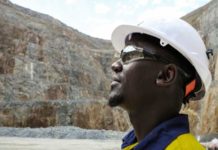
[miningmx.com] — GREAT Basin Gold will put itself under the microscope this year, an examination that could see the R6.4bn Johannesburg- and New York-listed gold mining junior restructure, possibly along the lines of Barrick Gold.
The Canadian gold producer last year demerged and separately listed its Tanzanian assets, retaining a minority stake which, it’s understood, it will release over time.
That’s one option that could fall to Great Basin CEO Ferdi Dippenaar. Current demands, however, suggest there are short-term goals to consider. One is getting a licence from Nevada’s Bureau of Land Management that will enable Great Basin to install power at its Hollister mine, where gensets currently do the work. Four years in the seeking, the licence will slash $50 per ounce off production. Great Basin is also applying to double gold production at Hollister, which will make the mine a meatier regional proposition.
The company’s other asset is Burnstone, the recently-opened Mpumalanga mine, which is a whisker from producing a profit. Outstanding capital items will negatively affect cash flow in the second quarter, but Dippenaar is hoping the capricious kimberley reef on which Burnstone is built can be tamed by mechanised mining techniques. He acknowleges market scepticism regarding this: some 10km of Burnstone’s orebody has been developed as the mining team needs as much flexibility when it’s off reef.
If these milestones can be reached, Dippenaar is hopeful he can reduce the discount at which Great Basin’s shares trade. The share is a significant underperformer. “We are in the top ten of most shorted companies on the NYSE,” says Dippenaar. “This year we have to prove we can mine from Burnstone, and further Hollister’s position. The next 12 months are crucial,” he says.
Not even Dippenaar is completely sure why the share trades as it does. All South African gold stocks have struggled, this year especially even as the dollar gold price rises, possibly as a function of the offsetting effect of the stronger rand and a rising cost base. Inflation is a global problem. In the US, tier one operators have guided an 11% to 18% operating cost increase this year.
Yet measured against Gold Fields, AngloGold Ashanti, Harmony Gold and Gold One International, Great Basin is a 31.5% underperformer on a relative basis, while Harmony and Gold One are 15% and 54% outperformers respectively. South African sovereign risk, operating risks, and the misfortune of having funds that also follow gold bear George Soros combined to weigh heavily on Great Basin. Shares in Great Basin Gold must be a screaming buy if Dippenaar deals with the mining as he hopes.
And so to unlocking the long-term value.
It’s clear the US and foreign investors are wary of the South African exposure. Therefore, one possibility is hiving off Hollister which would give choice to shareholders, attach a value to the Hollister mine, and perhaps provide the prelude to discussions with Newmont Corp, the world’s largest gold miner, about a joint venture with its fading Midas operation, a Hollister neighbour. Midas has the milling capacity to accommodate an expanded Hollister, hence the importance of growing Hollister’s output and making it a player in the region.
“I tried to buy Midas a little while ago as there is huge synergy with Hollister,” says Dippenaar. Once separately listed, Great Basin might then have greater clarity on what to do with its Mozambique and Tanzania exploration properties. “In the next 12 months we’ll go through a process of strategic review and how to unlock value. We have quality assets but they trade at a big discount. If it makes sense, we’ll split the firm,” says Dippenaar.











